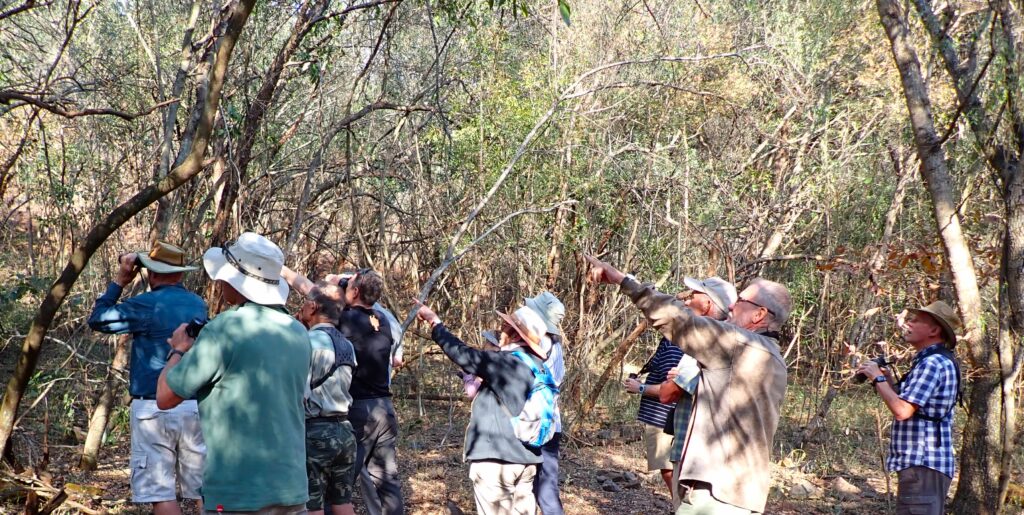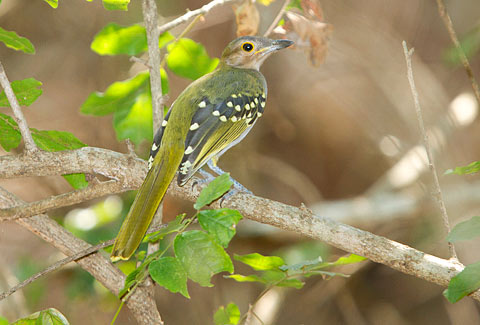
Where is it? There! Birders spotting an eastern nicator, a songbird that can be seen in riverine thickets on Mountainlands.
Recently, Birdlife Lowveld published an article about their August outing to Mountainlands in the Spring Edition of the club’s newsletter “The Hornbill”. The author of the article and bird guide, Mike Meidlinger, lead the visit and wrote an overview of birding on the reserve. We hope you enjoy his article as much as we did.
MAGICAL MOUNTAINLANDS: AUGUST CLUB OUTING
By Mike Meidlinger
One of the great joys of birding is being up before the sparrows and the crack of dawn, to be set, ready and to greet the new day before it has begun. The morning of Saturday the 27th of August was no different as, after a pre-dawn meet and a moderate one-hour drive from Nelspruit, we arrived with good light just starting in earnest. Our destination, the relatively under birded and private Mountainlands Nature Reserve nestled neatly between some of the oldest boulders on the planet.
Before reaching the reserve or entering its boundaries, it is hard to resist the temptation of spending a moment or two up at one or several of the traditional stopping points along the well-known and highly revered Saddleback Pass. A well-made strip of occasionally steep tarmac leads south of Barberton towards the Swaziland border. This road has long been renowned for its escarpment specials such as Buff-streaked Chat, Cape Rock Thrush, Red-throated Wryneck and Wailing Cisticola. Southern Tchagra is a somewhat scarce special for the area and is a bird best listened for as it releases a warped Tchagra-like trill that sounds oddly reminiscent of a Black-backed Puffback. There is also a certain element of luck required for this bird here at the northern tip of their range as often heard in the distance, persistence and good fortune are needed to find one close to the road. Other specials sought on the pass include Gurney’s Sugarbird and Malachite Sunbird which can both be found reliably at reliable locations when the road is quiet.
In terms of Mountainlands itself, the topography can be described as a series of cascading rocky to scrubby hillsides capped by a corner of true high-altitude grassland in its far reaches, laced with mixed ecotone valleys of thicket and forest, ending in a sort of typical savanna which predominates at the lower lying parts of the 24,000-hectare property.
Species that are common while descending from the entrance include fringe species like African Firefinch, Striped Pipit, Lazy Cisticola, Cape Batis and Bar-throated Apalis, while the whole property is an altitudinal migrant haven. The variation between which species can accumulate and even associate come from the wide variety of terrains which make up the reserve. This ends up meaning, 29 logically, that species expected or encountered varies greatly from day to day, season to season and sometimes, even hour to hour. What is clear in reserves with variations in habitat, altitude, and gradient such as this one, is that there is usually always some form of activity going on somewhere or another within its boundaries.
The bare rock faces and jumbled boulder strewn slopes hold staples like the aforementioned Cape Rock Thrush and Buff-streaked Chat, Cape Canary, Streaky-headed Seed-eater and the endemic Nicholson’s Pipit to name a few. There have been a few tantalising records of Cape Eagle-Owl from isolated evenings and mornings from nearby and with some persistence, the bird’s presence within the reserve is sure to be affirmed. Time spent looking to the skies is always worthwhile over the crests of the valleys, as species like White-necked Raven, Rock Kestrel, Jackal Buzzard, Rock Martin, African Black and Alpine Swift are present. Scarcer species that have been noted include Horus Swift, undoubtedly birds commuting from a nearby colony, Peregrine and Lanner Falcon, Long-crested Eagle, Black Sparrowhawk, and others. From the rocky outcrops, relatively gentle slopes that have large swathes of grass hold Cape Longclaw and Cape Canary while those that have bushes can yield a few transitional species such as Cinnamon-breasted and Golden-breasted Bunting, Black-crowned Tchagra, Lazy Cisticola and Black-headed Oriole.
Drainage lines and thickets are dynamic and exciting as it is here that dribs and drabs of both the montane forest and scrubby thicket coalesce in a cohesive blend of possibilities. Regular species in these areas include Yellow-breasted Apalis, White-browed Robin-Chat, Terrestrial Brownbul, Green-backed Camaroptera, Black-backed Puffback, Cape White-eye and Sombre Greenbul, which are staples but are also common in a number of habitats. Top quality bird’s indicative of the Lowveld, with a hint of forest, include Bearded Scrub Robin, Green Twinspot, Red-capped Robin-Chat, Gorgeous and Olive Bush Shrike, Purple-crested Turaco, Olive Woodpecker, Square-tailed Drongo, Narina Trogon, Yellow-fronted Tinkerbird, Spectacled Weaver and Scaly-throated Honeyguide to name a few.
What is fantastic is that in the past ten to fifteen years, there has been a number of range extensions by several species more typical of Kwa-Zulu Natal and Zululand. Once vagrants or unheard-of birds like Purple-banded and Olive 30 Sunbirds, Eastern Nicator and Black-bellied Starling are now regular at a number of spots in southern Mpumalanga. Most strongholds for these new additions range from Komatipoort to Nelspruit and Barberton while records are increasing in Whiteriver, the bottom of Kruger National Park as well as in and around Hazyview. Mountainlands itself has most of these species in abundance. Most are found in associating the properties well vegetated finger-like strips of lush vegetation that flow between hillsides.
There are also a number of records of current scarcities like Pink-throated Twinspot, Dark-backed Weaver and a number of unpredictable altitudinals which hopefully will prove more and more predictable as time goes on.
Interesting, there have been a number of records of Crowned Eagle flying over the reserve, and it is suspected that either there is a nearby pair, or these refer to adults from a nest approximately thirty kilometres away. If it is in fact the latter, then the valley is most likely a favoured route while on commute between their nest and good feeding grounds. Due to their preference for large, sometimes primate prey, they most likely pass over the lush tropical Afromontane forests of Peglar’s Bush and patchy forestry lands just beyond the reserve fence line. A number of cobbled streams which ebb and flow as they meander lazily downwards. Here there have been old records of Mountain Wagtail on small sectors of rapids, but this is rare here. In areas with waterside vegetation such as reeds and sedges as well as larger species alluvial trees, birds like Tawny-flanked Prinia, Golden, Thick-billed, Southern Masked and Village Weavers as well Red-collared and White-winged Widowbirds, Common Waxbill and their brood parasites, Pin-tailed Whydah, occur.
At the bottom of the valley, lies a significant amount of mixed bushveld that is undoubtedly sour but still holds yet another relatively unique ensemble of birds. This just adds yet more flare to the avifaunal community found in a space, for all intents and purposes, only a few kilometres by a few kilometres in dimension. Some species like Retz’s Helmetshrike, Crowned and Trumpeter Hornbill, give an exotic feel while others like Lesser Honeyguide, Grey Tit-Flycatcher, Ashy and African Paradise Flycatcher, are much more representative of the savanna contingent. Other typical broad-leaved Woodland birds found commonly also include Orange-breasted and Grey-headed Bush Shrike, White-crested Helmetshrike, Brown-crowned Tchagra, Golden-tailed and Cardinal 31 Woodpecker, White-browed Scrub Robin, a number of Robin-Chat species. Summer migrants bolster the ranks with upcoming additions like Red- chested, Black and Diederik Cuckoos, Willow Warbler, Woodland Kingfisher not to mention a number of summering hirundinids and raptors.
One of the scarcer raptors which is regular in this impressive reserve, during late summer, is the European Honey Buzzard. Once considered a very scarce Palearctic migrant this species has seemingly exploded from the woodwork at hotspots throughout the country. Over the past decade or so, this species has become more and more widespread and is being recorded with notable regularity around the Barberton region.
Overall, there is a constant mix of species which pass through and over the reserve all the times with certain pairs being resident and a number of other individuals, pairs and groups that are simply transitional and each day brings its own variety and variation. As if all that were not enough, there is a jewel in the crown of Mountainlands and the real hidden secret of the reserve, which is generally off limits to the public. Visiting requires being guided by a staff member through the small sections of undulating plateau grasslands fringing the south[1]eastern corner of property. This incredible habitat essentially aligns with the well-known hotspot, for birds such as Blue Swallow, of Malolotja National Park a short distance away in Swaziland.
Species that are found here are specialized for a completely different biome compared to down in the valleys. A host of smalls inhabit the short grass covered hillsides like Wing-snapping Cisticola, Plain-backed Pipit, Yellow Bishop and Cape Grassbird are common. In summer, and perhaps throughout the year, there are usually a number of the rare Broad-tailed Warbler that inhabit seepage lines and moist rank vegetation running through this area, it is most often picked up by its high-pitched squeak of a call in the wet months and its short aerial flap-and-glide display flight. Other inhabitants of the grassland include Denham’s Bustard, Red-winged Francolin, African Quailfinch and an even isolated pair of Cape Crow, plus sometimes numerous Common Quail in summer. Isolated pockets of primary Afromontane forests hold many species typical of the nearby Peglar’s Bush.
As well as this tropical flare to the avifaunal community, these small islands and valleys of green are ideal for uncommon fringe species like Red-necked 32 Spurfowl, Red-backed Mannikin, Swee Waxbill and Southern Tchagra, the latter of which is much more reliable here than on the tarred mountain pass. If time is spent exploring these remnant patches, species such as Forest Canary, Knysna Turaco, Chorister Robin-Chat, Grey Cuckooshrike, Yellow-throated Woodland Warbler, and African Emerald Cuckoo may be present, while Bush Blackcap has been suspected but yet to be recorded.
There is so much yet to be discovered here and the privilege of visiting this area is always humbling. With some effort there is much still to be discovered here with a number of records of the high prized Black-rumped Buttonquail, Striped Flufftail is thought to occur and there has even been a recent report of Short-tailed Pipit, just another illustration of what is possible within this highly diverse community reserve.
With its great potential, this section of the reserve remains closed to the public and is only accessible during club outings, which are arranged at the discretion of the reserve managers and owners who act on behalf of their stakeholders. Despite this, the reserve has an incredible amount of potential and when offered the chance it is a great privilege to bird in such an integrated and variable location.
As a whole though, Mountainlands is a fantastic place for birding, and it has much still to offer those able to explore its confines.

